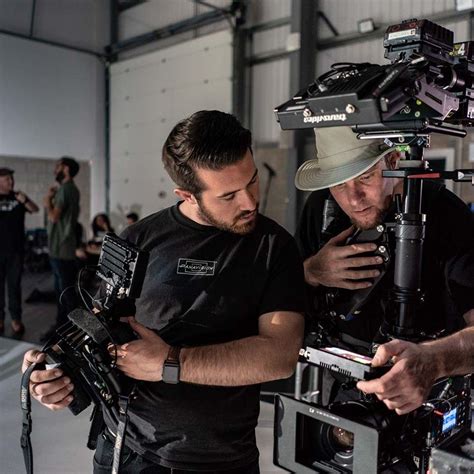Are you a theater enthusiast looking to make the leap into film and television production? Or perhaps you’re simply curious about how the magic happens behind the scenes of your favorite movies and shows. In this blog post, we will take you on a journey from stage to screen, exploring the fascinating world of film and television production.
We’ll start by delving into the basics of this dynamic industry, including the key differences between stage and screen production. From there, we’ll guide you through the entire process of bringing a script to life on the screen, discussing the crucial roles played by producers, directors, and casting directors. We’ll also explore the art of cinematography, visual effects, sound design, and post-production editing, shedding light on the intricate and collaborative nature of creating a film or television show. Whether you’re an aspiring filmmaker or simply curious about the magic of the entertainment industry, this blog post will provide a comprehensive look into the world of film and television production.
Table of Contents
Understanding the Basics of Film and Television Production
When it comes to Film and Television Production, there are many different aspects that come into play to bring about the final product that we see on the screen. From the initial concept to the final editing, each step in the process is crucial to the success of the project.
Scriptwriting is often the starting point for a film or television show. This is the blueprint for the entire project, outlining the dialogue, action, and overall story. The script is the foundation on which the entire production is built.
Once the script is finalized, the casting process begins. This involves finding the perfect actors to bring the characters to life. The actors chosen can have a huge impact on the success of the project, as their performances can make or break a film or show.
After the cast is chosen, the production phase begins. This involves filming the scenes, working with the cinematographer to achieve the desired look, and bringing the director’s vision to life. It’s a collaborative effort that requires coordination and teamwork from all involved.
Transitioning from Stage to Screen: Key Differences
When making the transition from stage to screen, there are a number of key differences that actors, directors, and other members of the production team must be aware of.
One of the main differences is the size of the performance space. On stage, actors must project their voices and movements to reach a large audience, while on screen, micro-expressions and subtle gestures are much more effective in conveying emotions to the viewer. This requires actors to adjust their performance style accordingly.
Another key difference is the relationship between the audience and the performers. In theater, there is a direct interaction between actors and the live audience, while in film and television, the audience is more of a passive observer. This can change the way actors approach their characters and the way directors frame their shots.
Furthermore, the technical aspects of production, such as lighting, sound, and editing, are handled differently in film and television compared to stage productions. Understanding these differences is crucial for a successful transition from stage to screen.
From Script to Screen: The Production Process
From Script to Screen: The Production Process
Once a script is completed, the production process begins in earnest. This stage of filmmaking involves a wide range of tasks, and it is the point at which the story truly starts to come to life.
Pre-production is the initial phase of the production process. This is when the project starts to take shape, and decisions are made about everything from budgeting and scheduling to scouting locations and hiring crew members. It is a critical stage, as it sets the groundwork for the entire film or television project.
As production gets underway, the filming or shooting phase commences. This is when the script is translated onto the screen and actors, directors, and crew members work together to capture the story’s essence. This phase can be both exhilarating and challenging, as the elements of the script are brought to life in a concrete, tangible form.
With all the necessary footage captured, the project moves into the post-production stage. This is when the editing, sound design, and visual effects come into play. It is a critical phase, as it is the last opportunity to shape the story before it is presented to audiences. The production process ultimately culminates in the final product—a film or television show that is ready for the world to see.
The Role of Producers: Bringing Stories to Life
Producers play a crucial role in the creation of films and television shows, serving as the driving force behind bringing stories to life on screen. They are responsible for overseeing all aspects of the production process, from script development to post-production, and work closely with directors, writers, and other key personnel to ensure that the final product meets their creative vision.
Producers are often involved in securing funding for projects, whether through a studio, independent investors, or other means. They must have a keen understanding of budgeting and financing, as well as the ability to negotiate deals and contracts to ensure that the production stays on track financially.
Additionally, producers are key players in the casting process, working with casting directors to find the perfect actors to bring the characters to life. They also oversee the hiring of crew members, from the cinematographer to the production designer, and are responsible for creating a collaborative and efficient working environment on set.
Throughout the post-production phase, producers continue to be involved, providing creative input and guidance to ensure that the final edit of the project accurately reflects the original vision. Their role is truly multidimensional, requiring not only creative instincts but also strong business acumen and leadership skills.
Directing for Film and Television: Techniques and Challenges
Directing for film and television requires a deep understanding of visual storytelling and the ability to lead a team of creative professionals in bringing a script to life. Directors must possess a strong vision for the project and be adept at communicating their ideas to the cast and crew.
One technique that is essential for directors is the ability to effectively work with actors. This involves not only understanding the nuances of performance but also being able to provide clear direction and feedback to help actors deliver their best work. It also requires a strong understanding of the emotional and psychological aspects of the characters in order to guide the actors in creating authentic, believable performances.
Another challenge that directors often face is managing the technical aspects of production. This includes working closely with cinematographers to achieve the desired look and feel of the project, as well as collaborating with the sound team to ensure that the audio elements enhance the overall storytelling. Additionally, directors must be skilled in coordinating with the editing team to ensure that the final product reflects their creative vision.
Directing for film and television is a complex and demanding role that requires a combination of artistic vision, leadership skills, and technical knowledge. Successful directors are able to navigate the challenges of the production process while inspiring their team to work together towards a shared creative vision.
Casting on Screen: Finding the Perfect Actors
One of the most crucial aspects of film and television production is the process of casting the perfect actors for the roles. A great performance by the cast can make or break a project, and finding the right individuals to bring the characters to life is essential for the success of the production.
When it comes to casting, one of the first steps is to clearly define the character breakdown for each role. This involves creating a detailed description of the character’s age, personality, physical appearance, and any other relevant factors. Understanding the essence of each character is key to attracting the right actors for the roles.
Once the character breakdowns are finalized, the casting process typically involves holding auditions to assess the actors’ suitability for the roles. During auditions, the casting team looks for individuals who can embody the essence of the characters and bring depth and authenticity to their performances.
Ultimately, the goal of the casting process is to find actors who not only have the necessary talent and acting skills, but also have the ability to connect with the audience and bring the characters to life on screen. The process can be challenging, but when the perfect actors are found, it can elevate the entire production to a new level of excellence.
Lights, Camera, Action! The Art of Cinematography
Cinematography is the art of capturing moving images through the use of a camera. It encompasses everything from the framing and composition of a shot to the manipulation of light and the choice of camera movement. The role of a cinematographer is crucial in setting the visual tone and style of a film or television show.
Lighting plays a key role in cinematography, as it can dramatically alter the mood and atmosphere of a scene. Cinematographers use various lighting techniques to create the desired effect, whether it’s a bright and cheerful ambiance or a dark and ominous one. They also work closely with gaffers and grips to set up the lighting equipment and ensure the right balance of light and shadow.
Camera movement is another essential aspect of cinematography. A cinematographer must consider how the camera moves within a scene to enhance the storytelling. Whether it’s a steady, fluid movement or a dynamic, handheld shot, the choice of camera movement can have a significant impact on the audience’s perception of the narrative.
Composition is the arrangement of visual elements within the frame of the shot. Cinematographers carefully consider the framing, symmetry, and overall visual aesthetics to create compelling images that support the narrative. They often collaborate with directors and production designers to ensure that the composition aligns with the creative vision of the project.
Visual Effects and CGI: Transforming the Screen
Visual effects and CGI have completely revolutionized the way we experience movies and television shows. These digital technologies have the power to transport audiences to fantastical worlds, create larger-than-life creatures, and bring unimaginable visuals to life on the screen.
One of the key aspects of visual effects and CGI is their ability to seamlessly blend with live action footage, enhancing the overall storytelling and visual impact of a production. Whether it’s creating a massive battle scene in a fantasy epic or bringing a beloved animated character to life, visual effects and CGI play a crucial role in captivating the audience’s imagination.
From motion capture to green screen techniques, the process of integrating visual effects and CGI into a production requires meticulous planning, technical expertise, and creative vision. The talented artists and technicians behind these effects work tirelessly to ensure that every detail is perfect, immersing the audience in captivating and believable visuals.
Visual effects and CGI continue to push the boundaries of what is possible on screen, allowing filmmakers to bring their wildest ideas to life and transport audiences to new and exciting worlds. As technology advances, the possibilities for visual effects and CGI are limitless, promising a future filled with even more awe-inspiring and transformative cinematic experiences.
The Power of Sound: Creating an Immersive Experience
Sound is a crucial element in creating an immersive experience for film and television audiences. It has the power to evoke emotion, set the tone, and enhance the storytelling process. From the dramatic score of a suspenseful scene to the subtle background noises that bring a world to life, sound plays a pivotal role in shaping the viewer’s connection to the on-screen action.
One of the key components of sound in film and television is the use of foley effects. These are the sounds that are added in post-production to enhance the auditory experience. From the sound of footsteps on different surfaces to the rustling of clothing, foley artists meticulously recreate these sounds to make the viewer feel fully immersed in the world of the story.
Additionally, the use of sound effects can transform a scene from ordinary to extraordinary. Whether it’s the roar of a dinosaur or the swoosh of a lightsaber, these effects add depth and excitement to the visual elements on screen. They bring a level of realism and excitement that would be lacking without them.
Finally, the use of music in film and television is an art form in itself. The right score can elevate a scene, convey emotion, and captivate an audience. From the iconic theme of a beloved superhero to the haunting melody of a horror film, music is a powerful tool that can make or break the impact of a story.
Post-Production: Editing and Finalizing the Project
After the long and intensive process of filming is complete, the next stage in bringing a film or television project to life is post-production. This crucial phase involves editing and finalizing the project, turning raw footage into a polished and seamless final product. Post-production is where the magic happens, as editors, sound designers, and visual effects artists work their magic to create an immersive and captivating experience for the audience.
One of the key elements of post-production is the editing process, where the raw footage is meticulously reviewed, organized, and pieced together to create a coherent and impactful narrative. Editors use their expertise to cut, trim, and rearrange footage, ensuring that the story flows seamlessly and engages the audience from start to finish. They also work closely with directors and producers to bring their vision to life, making creative decisions that enhance the overall storytelling.
Another crucial aspect of post-production is sound design, which adds depth and emotion to the visuals. Sound designers meticulously craft the audio elements of the project, from dialogue and ambient sounds to music and sound effects. Through careful mixing and editing, they create an immersive and realistic auditory experience that complements the visuals and enhances the overall impact of the project.
Visual effects and color grading are also essential components of post-production, as they transform the raw footage into a visually stunning and cohesive final product. Visual effects artists use cutting-edge technology to enhance the visuals, create CGI elements, and bring fantastical worlds to life. Meanwhile, colorists fine-tune the color palette of the project, adjusting the hues and tones to create the desired mood and atmosphere, and ensure visual consistency throughout the project.





